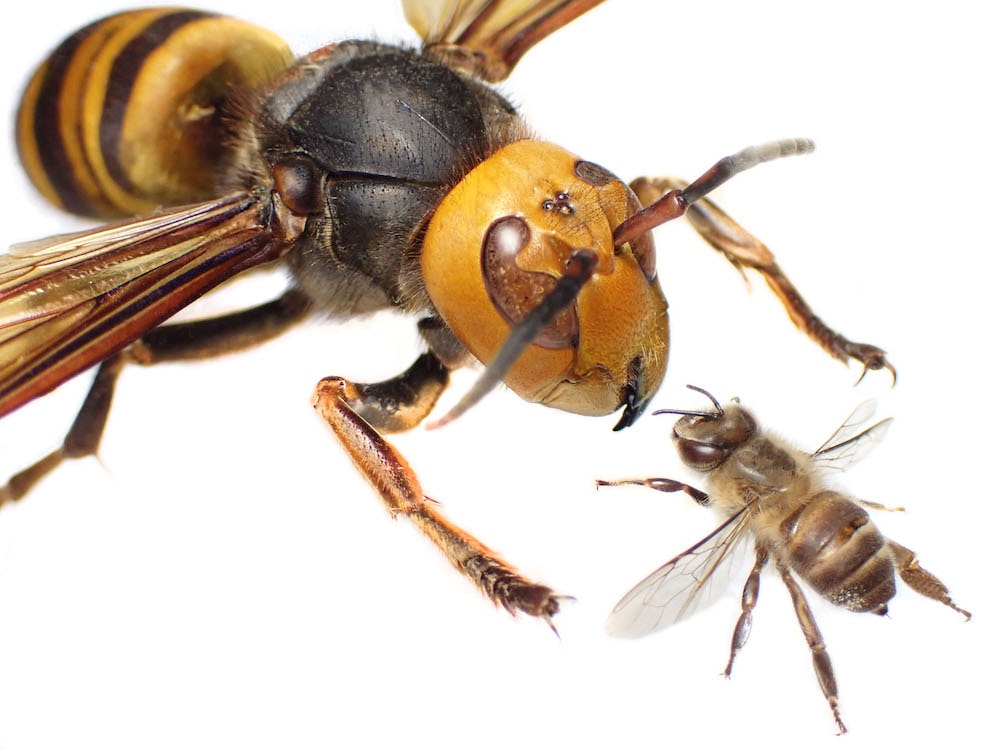Create a free profile to get unlimited access to exclusive videos, sweepstakes, and more!
Bees scream bloody murder when attacked by monster hornets
If one bee senses danger, it can set off the entire hive.

Murder hornets and their murderous cousins are enough to freak out a human, so it should be no surprise that bees shriek if they run into one. They just do it differently.
Bees don’t have a voice, but what they do have are other ways of generating a noise so close to a human scream that it haunted behavioral ecologist Heather Mattila of Wellesley college, who was studying how Asian honeybees use animal dung as hornet repellent when she first heard the noise. You would scream too if that was the only way to ward off a beast several times your size that would kill you and steal your larvae. Bees are social creatures. If one senses danger, it can set off the entire hive.
Mattila, who led a study recently published in Royal Society Open Science, noticed something eerie when she played back recordings of hornet attacks. There would be a roar of frantic buzzing when the infamous murder hornets Vespa mandarinia or the larger and even more terrifying Vespa soror (above) came for the hive. The same thing would happen when she and her colleagues would douse pieces of paper in hornet pheromones and record the reaction.
“It quickly became apparent that there were signals which didn't look like the sounds bees make when giant hornets aren't present, and hadn’t been published before for this species,” she told SYFY WIRE. “It was obvious because there were so many of them and the bees kept making them over and over.”
Hornets can be loud, but the screaming sounds of the bees were unmistakable. Mattila’s recordings of actual hornet attacks were overrun with the sounds of the invaders, so she used software that made it possible to analyze the acoustic properties of sounds that were made every second. They are actually a variation on pipes — signals that bees regularly communicate with. Vibrating muscles in the thorax produces pipes, and other bees pick up on the frequency and duration of these signals with sensors in their legs. This is their way of “hearing” things.
When worker bees sense approaching predators, their pipes are extremely specific. The panicked buzzing comes from beating their wings as hard as they possibly can. They will also raise their abdomens in the air, and were often seen running in this position as they “screamed.” They are thought to do this as the fastest way possible to tell others to prepare for an attack. Because the vibrations will go through a bee’s wings, thorax, and legs into the part of the hive it is standing on, the message will reach other bees’ legs and warn them of impending danger.
“Vibroacoustic signals travel quickly, so this is a great way to let other bees know that there is an attack happening the moment it starts,” Mattila said. “We don't know whether this signal starts a specific defense. It could be that its purpose is to gather bees at the entrance of the nest so that they can use any defense possible.”
Bees also release pheromones through a gland in their abdomens when murderous hornets are charging at them, though the reason for this is still unknown. These same pheromones have been previously observed making bees cluster. It is possible that they add to the urgency that causes workers to gather and prepare for an onslaught of hornets. Methods of defense they use against the attackers include instantaneous fecal spotting and bee balling, in which the bees are able to catch a hornet and gang up on it in a furiously buzzing ball until the dreadful thing is dead.
To find out the exact meaning of the signal, Mattila will have to run more experiments in which she plays the recorded screams to colonies that are not in danger so she can see how they respond. Will it tell them something like, “Monster hornets are coming to slaughter us and make off with our larvae to eat them!”? This will be useful to determine whether European honeybees, which do not face hornet attacks, recognize it as a call to action in the face of death.
“We think that this research highlights how important good defenses are against hornets,” she said. “European honey bees don't have the hornet defenses that Asian bees have, so it shows us how urgently they need protection from hornets wherever they are introduced.”
What a way of telling your enemy to buzz off.


























